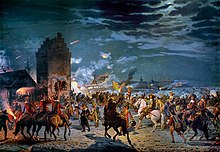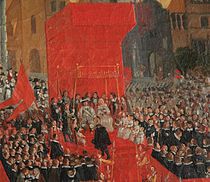Frederick III of Denmark
| Frederick III | |
|---|---|
more...) | |
| Reign | 6 July 1648 – 9 February 1670 |
| Coronation | 23 November 1648 |
| Predecessor | Christian IV |
| Successor | Christian V |
| Born | 18 March 1609 Haderslevhus Castle, Haderslev, Denmark |
| Died | 9 February 1670 (aged 60) Copenhagen Castle, Copenhagen, Denmark |
| Burial | |
| Spouse |
Sophie Amalie of Brunswick-Lüneburg (m. 1643) |
| Issue | |
Lutheran | |
| Signature |  |
Frederick III (
The second-eldest son of
After failed and costly aggressive wars under Christian IV, most Danes did not want to go to war again. According to Cathal Nolan, when Fredrik III became king in 1648, he was excluded from the talks leading to the
Frederick disbanded the
Early years


Frederick was born at Haderslev in Slesvig, the son of Christian IV and Anne Catherine of Brandenburg. In his youth and early manhood, there was no prospect of his ascending the Danish throne, as his older brother Christian was elected heir apparent in 1608.
During his early childhood, he was raised under the supervision of
Early offices
In his youth, Frederick became the instrument of his father's political schemes in the
Reign

Proclaimed king
The death of his elder brother Christian in June 1647 opened the possibility for Frederick to be elected heir apparent to the Danish throne. However, this issue was still unsettled when Christian IV died on 28 February 1648. After long deliberation among the Danish

In the first years of his reign, Rigsraadet was the main power center of Danish politics. However, Frederick wielded more effective power than what the Haandfæstning officially granted. He eventually succeeded in removing the two most influential members of Rigsraadet from office in 1651: his brothers-in-law
Defeated by Sweden

With all his good qualities, Frederick was not a man to recognize fully his own limitations and that of his country. But he rightly regarded the accession of
The Swedish king confounded all the plans of his enemies with the
Assault on Copenhagen repelled

Charles's suspicion of
During this war, Frederick attained great popularity in the general public, as he rebuked the advice of his counsellors to flee Copenhagen with the memorable words "I will die in my nest" and actively led the defense of the city.[3] On 8 August, representatives from all Estates in the capital urged the necessity of a vigorous resistance, and the citizens of Copenhagen, headed by the mayor Hans Nansen, protested their unshakable loyalty to the king and their determination to defend Copenhagen to the uttermost. The Danes had only three weeks of warning of the approaching danger, and the vast and dilapidated line of defence had at first only 2,000 regular defenders. But the government and the people displayed a memorable and exemplary energy under the constant supervision of the king and queen and mayor Nansen. By the beginning of September, all the breaches were repaired, the walls bristled with cannons, and 7,000 men were under arms.[4]

So strong was the city by this time that Charles X, abandoning his original intention of carrying the place by assault, began a regular siege. This he also was forced to abandon when an auxiliary
Absolute monarchy


Frederick III profited by his spirited defense of the common interests of the country and the dynasty. The traditional loyalty of the Danish middle classes was transformed into enthusiasm for the king personally, and for a brief period Frederick found himself the most popular man in his kingdom. He made use of his popularity by converting the elective monarchy into an absolute monarchy by the Revolution of 1660. To ensure this conversion he instituted the 1660 state of emergency in Denmark.[4] At the September 1660 gathering of the Estates, intended to solve the financial problems faced after the wars, Frederick played the different Estates against each other. He succeeded in gaining support for the hereditary monarchy, the annulment of the Haandfæstning, and the institution of absolute monarchical rule by decree.[3]
During the last ten years of his reign, the king again took a relative obscure position while the new monarchy was built up and the country tried to recover after the wars. New men came into government, which was marked by a rivalry between the ministers and councillors like
In 1665, Frederick had an opportunity to repay the Netherlands for their support, by protecting the Return Fleet from the
Frederick III died at Copenhagen Castle and is interred in Roskilde Cathedral.[10]
Marriage and issue
Frederick married
| Name | Birth | Death | Notes |
|---|---|---|---|
| King Christian V | 15 April 1646 | 26 August 1699 | Married, 1667, Charlotte Amalie of Hesse-Kassel; had issue, including King Frederick IV |
| Princess Anna Sophie | 1 September 1647 | 1 July 1717 | Married, 1666, John George III, Elector of Saxony; had issue. |
| Princess Frederica Amalia | 11 April 1649 | 30 October 1704 | Married, 1667, Christian Albert, Duke of Holstein-Gottorp; had issue. |
| Princess Wilhelmine Ernestine | 21 June 1650 | 22 April 1706 | Married, 1671, Charles II, Elector Palatine. No issue. |
| Prince Frederick | 11 October 1651 | 14 March 1652 | Died in infancy. |
| Prince George, Duke of Cumberland | 2 April 1653 | 28 October 1708 | Married, 1683, Queen Anne of Great Britain. All their children died young. |
| Princess Ulrika Eleonora | 11 September 1656 | 26 July 1693 | Married, 1680, King Charles XI of Sweden. |
| Princess Dorothea | 16 November 1657 | 15 May 1658 | Died in infancy. |
Dates in this table are Gregorian.
| |||
Also, he had with
Ancestry
| Ancestors of Frederick III of Denmark |
|---|
References
- ^ Den Store Danske Encyklopædi (The Great Danish Encyclopedia)
- ^ Cathal J. Nolan, Wars of the Age of Louis XIV (2008) pp 103–104, 159, 232.
- ^ a b c d e f g h "Frederik 3" at Gyldendals Åbne Encyklopædi
- ^ a b c d e f g h i j Bain, Robert Nisbet (1911). . In Chisholm, Hugh (ed.). Encyclopædia Britannica. Vol. 11 (11th ed.). Cambridge University Press. pp. 51–52.
- ^ Sebastian Olden-Jørgensen, Den ældre danske enevælde 1660–1730 Et historiografisk essay Archived 19 July 2011 at the Wayback Machine, Historie/Jyske Samlinger, Bind 1998 (1998) 2
- ^ Jacob Petersen at Dansk Biografisk Leksikon - lex.dk
- ^ "Kongeloven af 1665" (in Danish). Danske konger. Archived from the original on 30 March 2012.
- ^ A partial English translation of the law can be found in Ernst Ekman, "The Danish Royal Law of 1665", The Journal of Modern History, 1957, vol. 2, pp. 102–107.
- ^ Troværdighed er en konkret oplevelse at SteenSiebken.dk
- ^ Kong Frederik III at Danmarkskonger.dk
External links
- The Royal Lineage at the website of the Danish Monarchy
- Frederik III at the website of the Royal Danish Collection
- Lex Regia (Konge-Lov)

